I recently went to South Africa to speak at a workshop on research prioritization for zoonotic disease prevention and control (more details on it here: this site is largely “under construction” and this is the only thing I have managed to write up till now!). I took a ton of pictures there and I thought of creating a photo narrative with some of those. As you may know I am testing out the field of photography, so any constructive comments will be highly appreciated. I have licensed these images under a creative commons license (see below) so please feel free to re-use them in accordance with the CC policies. I would greatly appreciate it if you could give me a heads up if you decide on using these images.
So, on to the photo-narrative then!

Based on a work at http://scepticemia.com.
We landed in Johannesburg, and the workshop was scheduled to be held at the Hans Hoheisen Wildlife Research Station (HHWRS), which is located in the heart of the Kruger National Park. That meant that we had an almost 650 km drive ahead of us. All the participants congregated at the airport and were picked up by a mini-van, which was our ride for the next seven or so hours.
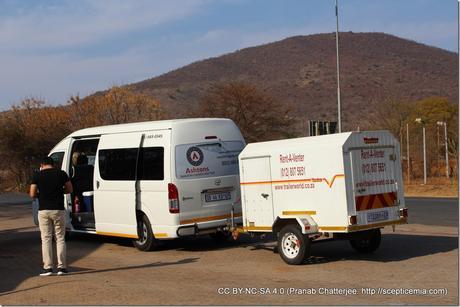
We made a number of stops to stretch our legs and to break the monotony of driving along. The first of the stops was at a place called Azul, which was basically a place where people traveling on the highways bought (slightly overpriced) food from. However, the USP of this place was the fact that while you were munching on the food, one could look out into the vast meadows, which seamlessly merged into the forests far away, and enjoy the sight of semi-domesticated wild animals thronging to a watering hole.
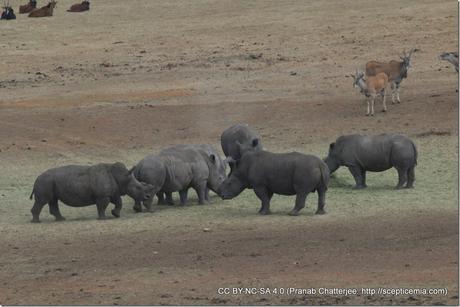
A family of rhinos
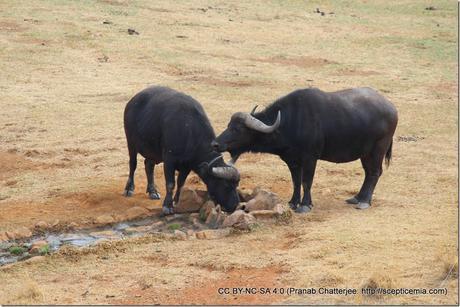
Two wild buffaloes at a watering hole
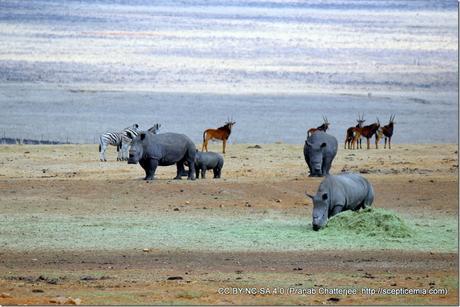
Rhinos, Antelopes and Zebras peacefully grazing near the watering hole.
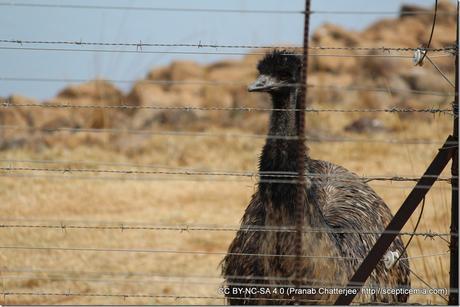
An ostrich… looking really thoughtful as it gazes on throngs of human beings chomping on burgers.
Although the drive was long, I personally did not feel bored for a second, mainly because the roads were amazing and I was captivated by the rolling meadows and fields that we drove through, as the clouds played hide and seek with the sun.

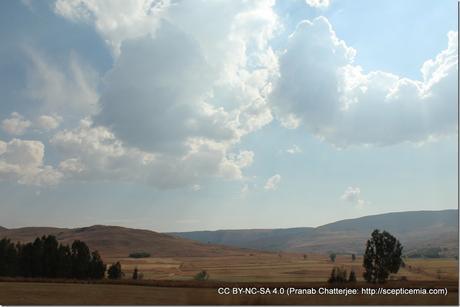
The next stop was a small, sleepy, old world town called Ohrigstad. There is an interesting tale about the town. This town initially came into existence because people started to find gold nuggets in a river nearby. However, nobody could stay long enough to mine them because the area was ravaged by malaria and mosquitoes bearing a number of killer diseases. The sick people were transported to the nearest medical center in another nearby town, which was called Lydenberg, which in the local language meant “suffering”. Lydenberg apparently got its name from the masses of “suffering” prospectors that ended up in their town to get treatment for nasty vector borne diseases!
Unfortunately for me, we were in a huge hurry and could not spend time trying to track down gold in the river.
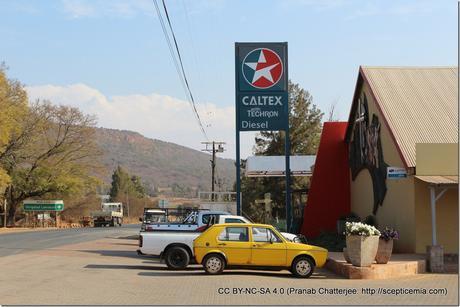
We started our cross-country trip from the highlands or the high velds, and drove on towards the low velds.
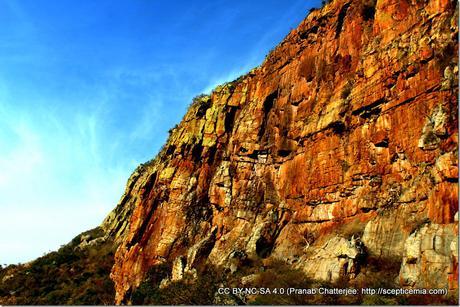
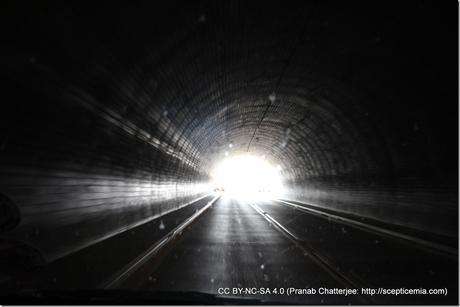
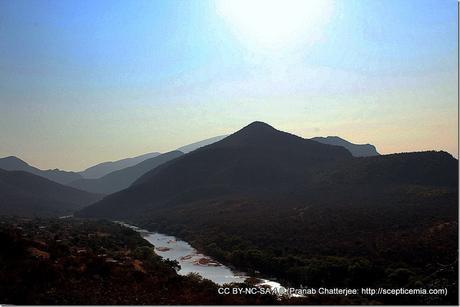
And when when we looked back, a serene sight met our eyes!
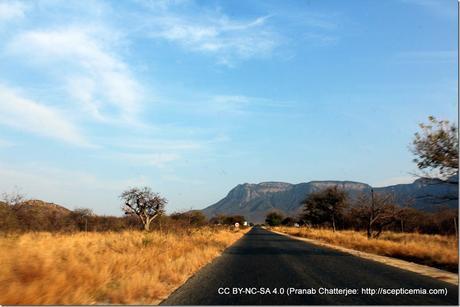
Once we were clear of the hills, the roads clung to dry grasslands that were separated from the adjacent forests by electified barbed wire fences.
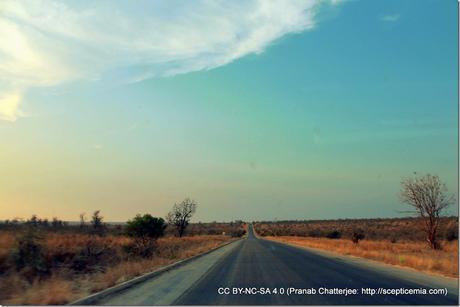
When we finally crossed the Orpen gate and entered into the Kruger National Park, we were met with a sort of barren, dry forest; quite different from the tropical jungles I have been acquainted with in India.
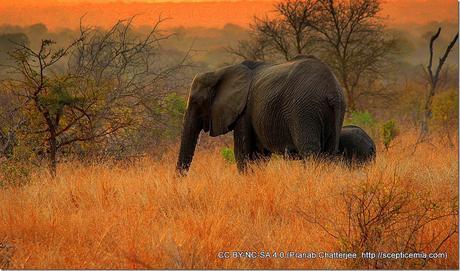
We did not have to wait too long before we were welcomed into the wild wastelands by a small clutch of elephants chomping away at the bark of dried up trees.
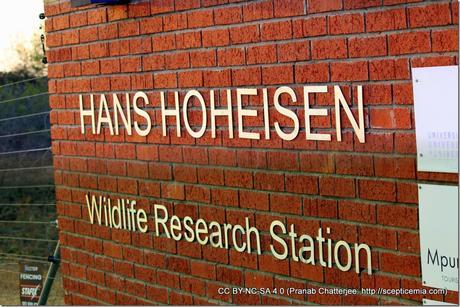
Six kilometers inside the Kruger National Park lay our destination, the Hans Hoheisen Wildlife Research Station, which is overseen by the University of Pretoria.
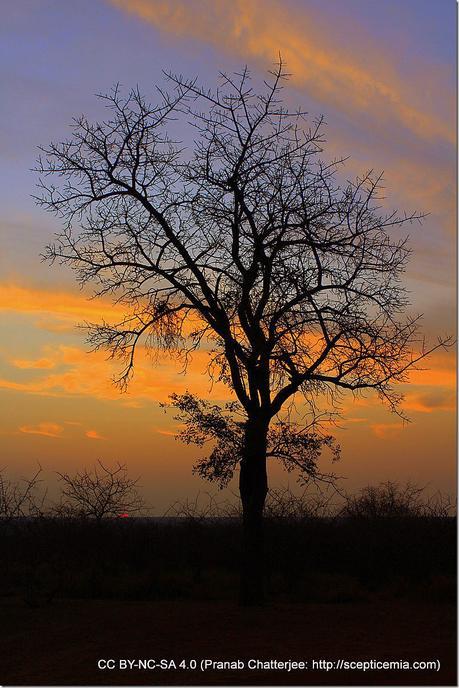
The sunset that greeted us was mesmerizing. The colors ran riot, as we stood wand watched, transfixed.
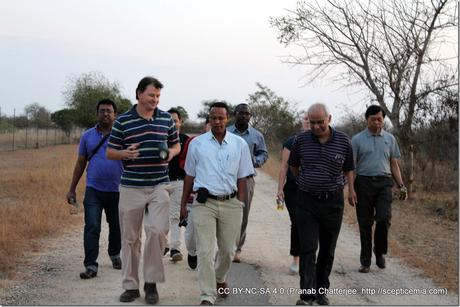
We stepped out into the dying light of the evening to explore the premises of the research station and get acquainted with each other.
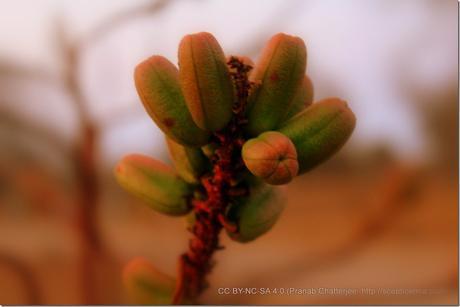
In the cold, dry evening, we encountered a slew of flora that I had never seen before.
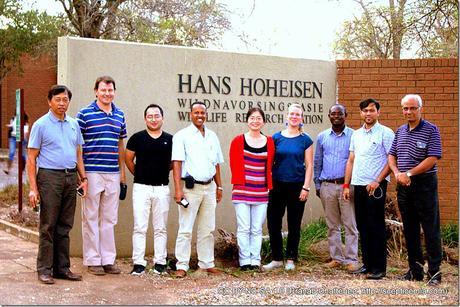
The participants of the workshop. In the image: From left to right: Wayan Tunas Artama (Ecohealth/One Health Resource Center, Indonesia), Greg Simpson (Hans Hoheisen Wildlife Research Station, University of Pretoria, South Africa), Vivek Kattel (BP Koirala Institute of Health Sciences, Nepal), Mekonnen Yitagele (Haramaya University, Ethiopia), Lai Jiang (Institute of Tropical Medicine, Belgium), Evelien Paessens (Institute of Tropical Medicine, Belgium), Richard Akuffo (University of Ghana, Ghana), Pranab Chatterjee (Public Health Foundation of India, India), Manish Kakkar (Public Health Foundation of India, India). Not in picture (because she was clicking this pic): Fabiola Quesada (University of Pretoria, South Africa).
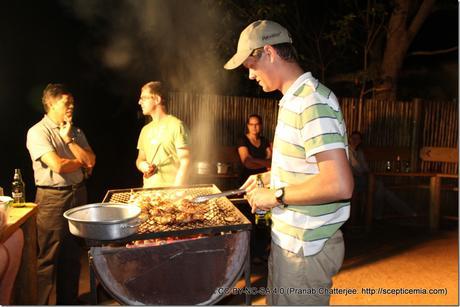
Come the evening, and we were out in the open, meeting up for the Braai. Braai is short for braaivleis, which means a picnic or barbecue where meat is grilled over an open fire.
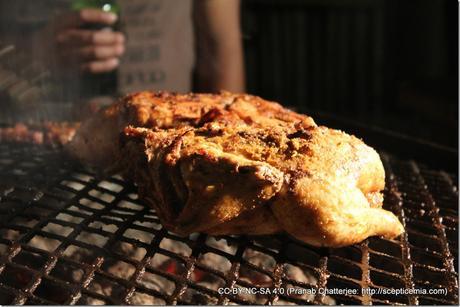
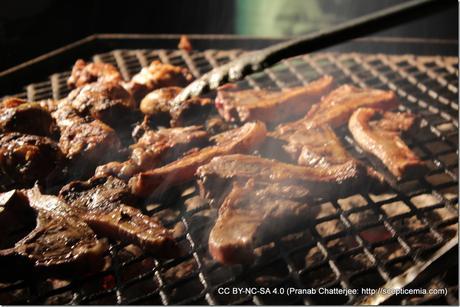
Even as I sit here writing this, days afterwards, the sights and smells of the evening comes back to me, arousing a deep longing to go back to the evening under the starry skies.
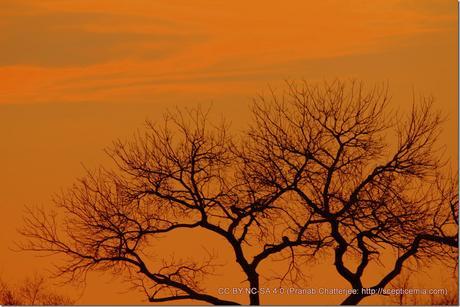
The following evening, after the first day of the workshop was done, we set out on a game ride, out into the forest that lay all around us.
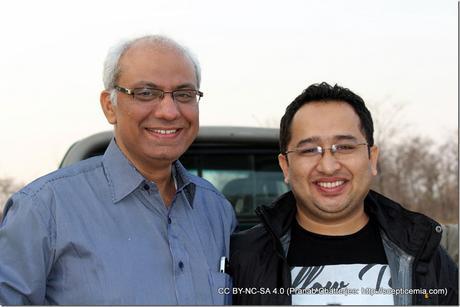
A sense of excitement pervaded the air as we recounted jokes about how we just needed to outrun each other, and not a chasing lion, should such an occasion arise. Dr. Kattel was fresh up from a nightmare in which he was being chased by a lion; we briefly considered leaving him behind as we were loathe to lose a workshop participant.
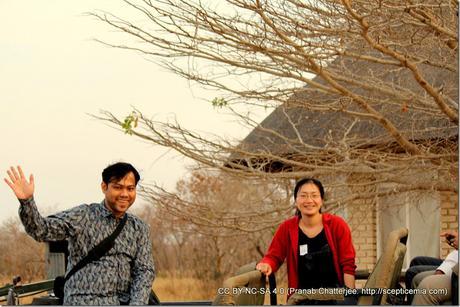
As the evening sunrays lost their warmth, and the chill in the wind started to bite, we flagged off our journey into the depths of the forest.
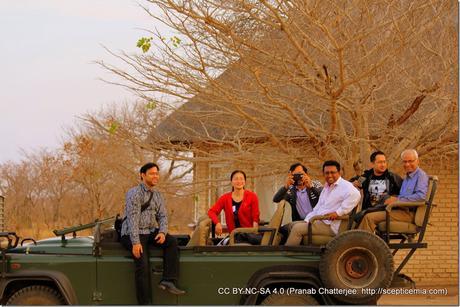
We piled into an open jeep, and our guide, Prince, warned us to stay within the confines of the vehicle and not get too adventurous.
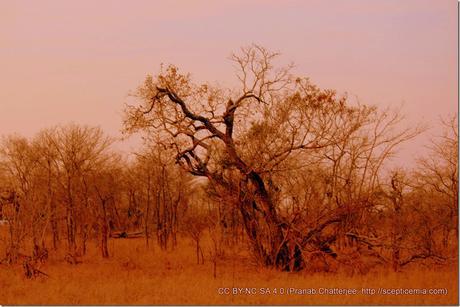
We tracked broken trees as we were on the heels of elephants.
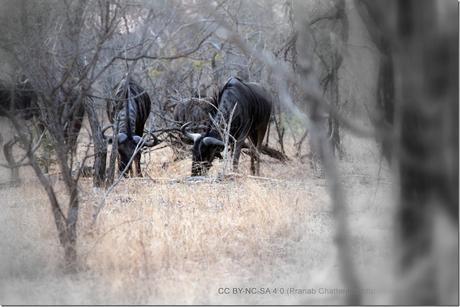
We ran into a herd of Wildebeest; these animals prefer to stay in groups. They are, however, uniquely being affected by their own instincts and the impositions fences have put on them. Apparently, if they get chased by predators (lions, usually), these animals take to heels, but they like to return to their territories after they have managed to avert the predator. However, now, since the forest is divided into private and government players, and each has their territories fenced off, their fleeing-returning paths have become shorter. Consequently, now the lions chase off a herd, and lie in wait… they eventually come back, and the lions get one of them. However, these wildebeest roam with impalas, which is a kind of small deer that has good sense of survival. So, now, if the impalas are not willing to venture back to their territories, the wildebeest also stay away! Prince, our guide, told us this fascinating story of how life and evolution always finds a way out in the wild!
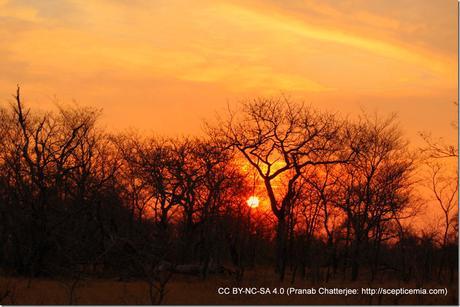
I could keep taking pictures of how wildly intoxicating the sunsets feel out there in the wild!
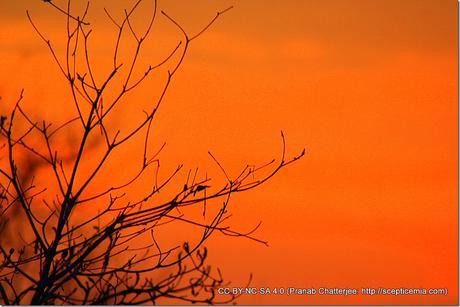
As the darkness gathers and animals either come out of their day time lairs or start to look for shelter and protection, there is a perceptible change in the forest.
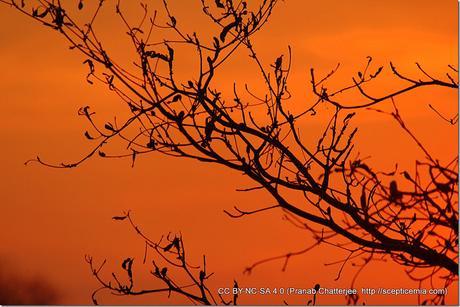
I was surprised by the lack of flocks of birds heading back to their nests, which is a characteristic of tropical Indian forests… and was informed by our guide that birds tend to live clustered around the watering holes, which we were a bit far away from.
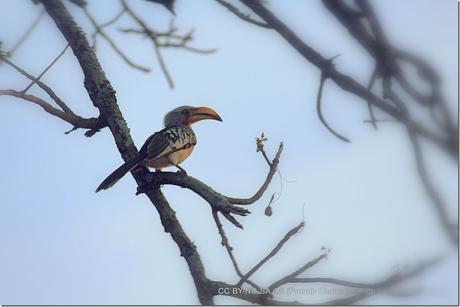
Not long after I had expressed my surprise at not seeing birds, we came across this Hornbill, which is called a “Banana bird” in the local language (for obvious reasons – look at its beak!).
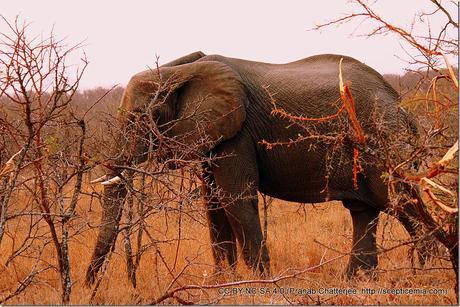
Not too long after we had started to track the broken trees, that we chanced upon this 35 year old bull elephant, all alone, chomping away happily.
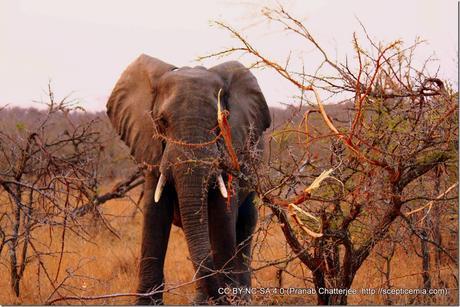
The low velds were coming out of the dry, cold, barren winters; the elephants have found a way to survive this harsh weather. They, quite literally break open trees, and feed on the sap and tissues inside. This provides them with the nourishment and moisture needed for survival.

It was a humbling sight to see the huge, majestic elephant, so close, in its own habitat.
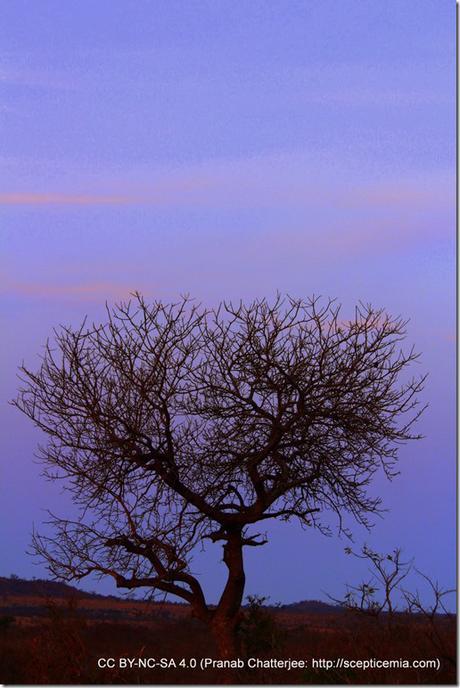
As the evening gathered, we came across a few other animals, notably, amongst them a group of crocodiles feeding on a dead buffalo that had been hunted down by a lion a day before; hyenas that crossed the road; more elephants; a hippopotamus that was half submerged in a stream; herds upon herds of zebras and wild buffaloes; some wild dogs… but the big one, the lion, stayed out of our sight.
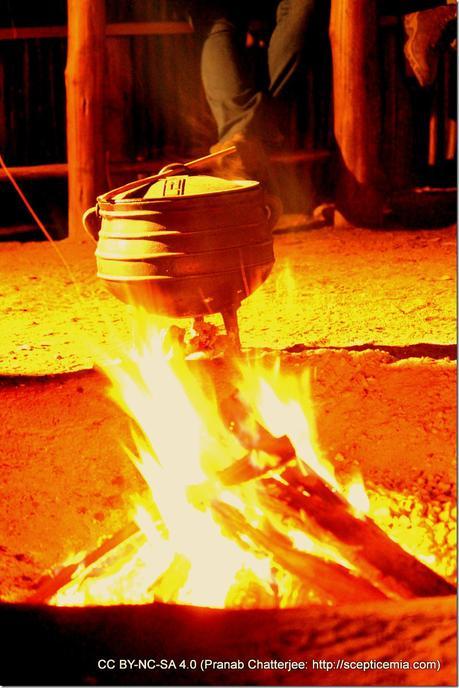
When we returned to the research station, a cheery bonfire was going on, and a poike pot was brought out to prepare a stew for that day’s dinner. The Poike pot gets its name from the Afrikaans word, Potjeikos, which, literally translated, means “food that fits in a small pot”. The Potjie, a small, iron, three-legged pot is an adaptation of the iron oven in by the Dutch around the 17th century. The wikipedia page says:
Potjiekos originated with the Voortrekkers, evolving as a stew made of venison and vegetables (if available), cooked in the potjie. As trekkers (pioneers) shot wild game, it was added to the pot. The large bones were included to thicken the stew. Each day when the wagons stopped, the pot was placed over a fire to simmer. New bones replaced old and fresh meat replaced meat eaten. Game included venison, poultry such as guinea fowl, warthog, bushpig, rabbit and hare.
As we sat, gathered around the cheerful fire that warmed the cold evening air, we planned another trip out into the forests next morning. A visit to South Africa without seeing a lion is simply unacceptable!
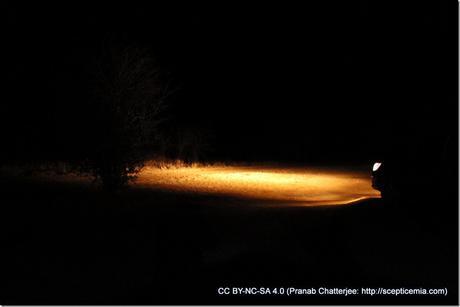
It was still dark outside when we all piled into the jeeps and headed out; we were all thinking the same, unspoken thought: shall we see some predators today?
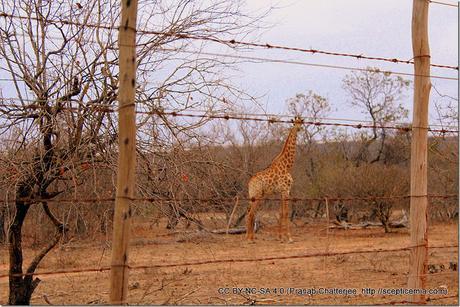
A sense of optimism flooded us when we spotted a couple of giraffes (that were quick to run away from us) the very first moment that we drove into the game park.
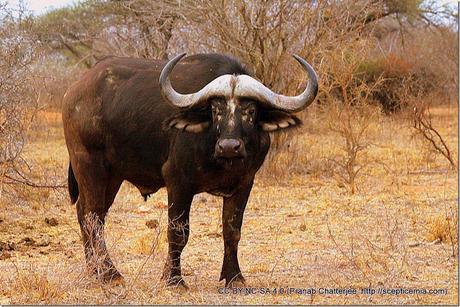
We also met a herd of wild buffaloes led by an irritated looking, battle scarred bull.
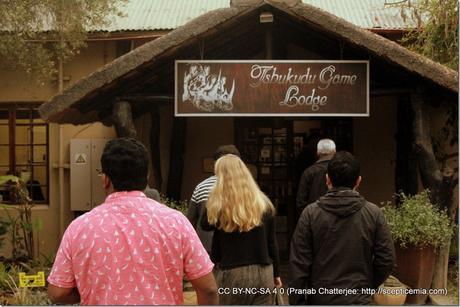
We had gone to the Tshukudu Game Lodge, which is a private bit of forest, housing some animals in their wild habitat. South Africa has a unique system where they have privatised wildlife and even provided legal sanction to controlled hunting. This has apparently led to espousal of the cause of wildlife conservation by private agencies which either use them for viewing by visitors or for hunting in season to generate revenue. Previously, these animals used to be akin to pests, either killing livestock (predators) or eating up the meager resources the herbivores depended on. Now, however, the private players are interested in rearing and protecting these wild animals so that they can be showed to or hunted for money. There are transactions to the tune of millions in this business depending on the grandiosity of the animals concerned. A virile bull, which had huge horns and stood an imposing height, had apparently been sold for US$ 4 million so that it could breed with the other wild buffaloes and have progeny with such desirable traits that make them a premium commodity for hunters. I personally felt very conflicted because on one hand this is a plausible mechanism to force the private players to invest in conservation; but at the same time, this legal sanction of hunting sounds morally disagreeable… but that is a debate for another day!

In the local language, Tshukudu means rhinoceros, and true to its name, a couple of rhinos sat out in the open, enjoying the warmth of the winter sun, and feeding on the grass.
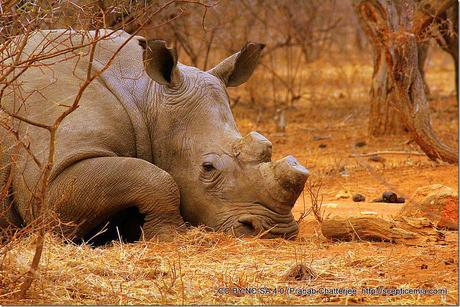
A closer look at the rhinos revealed that their horns had been cut off. These majestic beasts are relentlessly poached for their horns which used to find a lot of use in traditional Chinese medicine. Now that snake oil medicine is on the wane, its use as a medical aid has gone down, but the difficulty of obtaining a rhino horn has made it one of the most desirable objects for collectors. Rhinos that are kept in private properties have their horns sawed off periodically so as to discourage poachers from killing them. Rhino horns are like our hair or nail, it is basically keratinous and may grow upto 7 cm per year. While it is officially illegal to sell the horns that have been sawed off to protect the animal from being poached, local people are skeptical as to how far that rule is implemented.
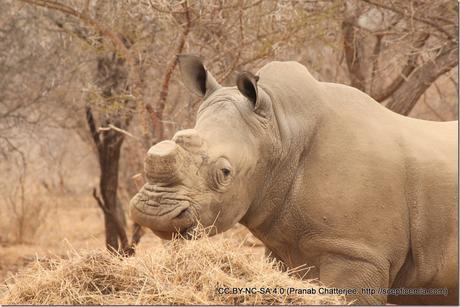
I felt sad that such gloriously beautiful creatures had to have their body parts sawed off just to save them from the unending greed of man. Every year about 1500 rhinos are poached in South Africa, according to the local sources. Kruger officials have estimated that they have about 15,000 rhinos (though our guide from Tshukudu believed that it is a massively inflated number and only half as many are likely to actually exist). If the poaching business does not stop soon, that day is not far off when the African Rhinoceros will join the list of extinct creatures.

Not long after we had trudged out into the forest did our guide tell us to quiet down because he was leading us to a kill that a lioness had made last night. He suspected that if we could creep up unnoticed, we might get a look at a pride of lions.
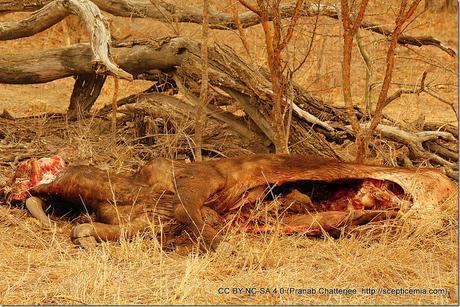
The stench hit us before we actually saw the carcass of the dead buffalo.
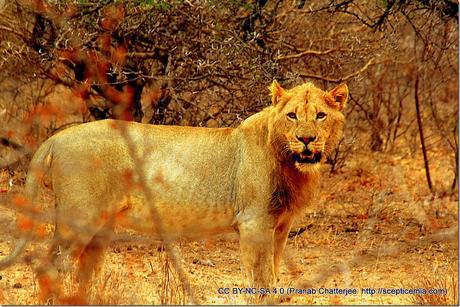
And right thereafter, we saw her. The monarch of all she surveys, getting disgruntled by the uninvited guests interrupting her breakfast.
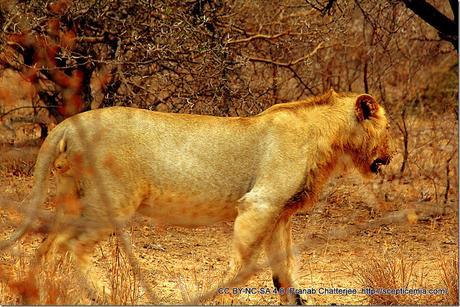
She stood awhile, looking dead straight at us, almost as if making up her mind to charge us or not… but then decided against it and walked off into the dense shrubbery, much like a celebrity does after their appearance for a photoshoot to satisfy their fans.
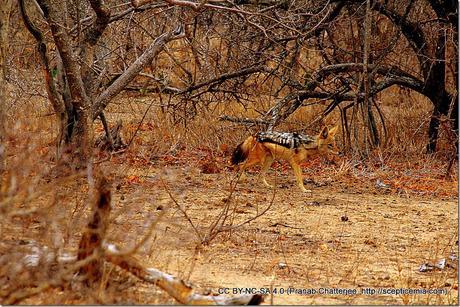
No sooner had the lion walked away did our guide attract our attention to a small animal crawling out from behind the bushes. A jackal. He was just waiting for this moment when the lion would walk off and leave the kill unguarded so that it could come out and have its share.
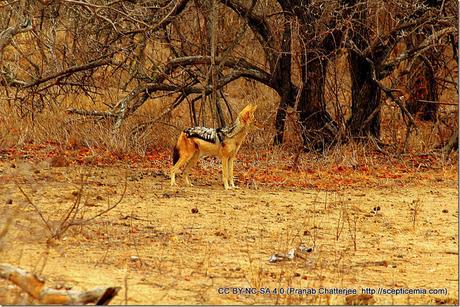
The jackal did not seem entirely convinced though, and probably sensed that the lion was around, so he did not stick around for too long and went back into hiding from whence it had emerged!
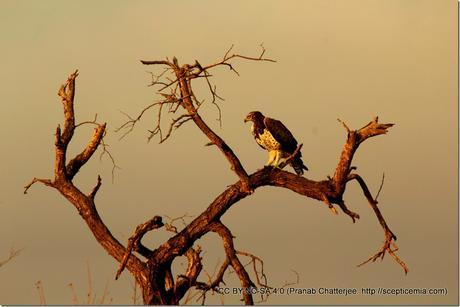
We drove further into the forest and chanced upon a Martial Eagle.
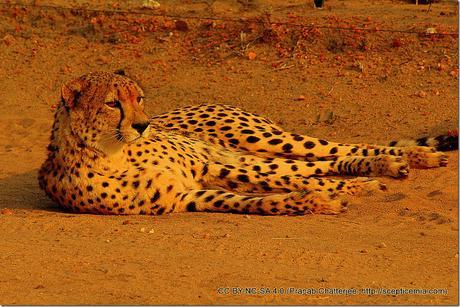
One of the major attractions of the Tshukudu Game Lodge are the resident pet Cheetahs. Yeah. You read that right. Pet Cheetahs that were orphaned and then hand raised at the lodge. The lodge has three cheetahs, two brothers (Floppy and Hunter) and a sister (Mtombi). These cheetahs, though they were hand raised, were returned into the wild. They are not fed by the lodge people and hunt for their food. However, they have remained “tame” to an extent that they allow strangers to not only reach out to them, touch them, pet them or play with them, but also walk alongside them in the forest tracks. We wasted no time in getting acquainted with these celebrity cheetahs that have previously been featured on UK Newspapers.
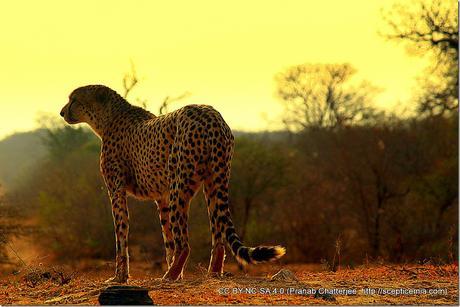
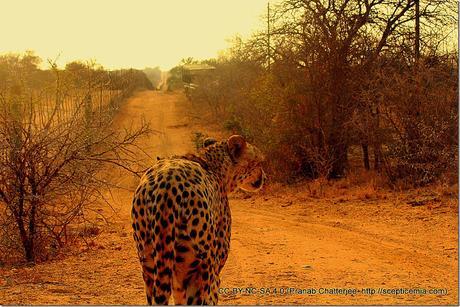
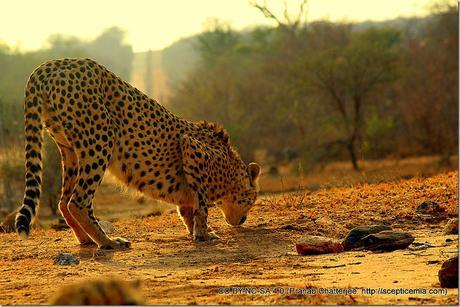
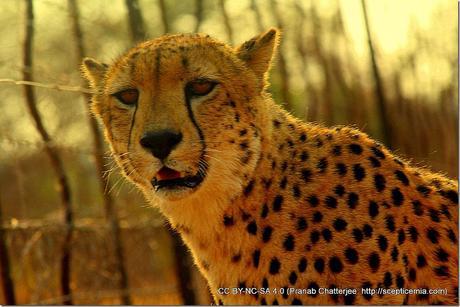
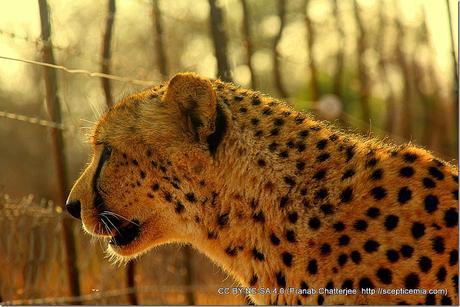
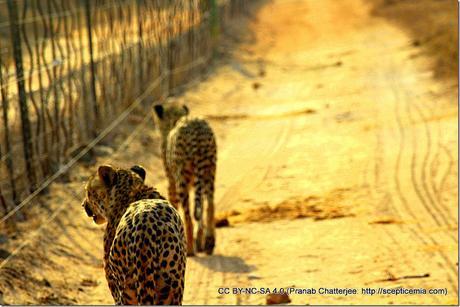
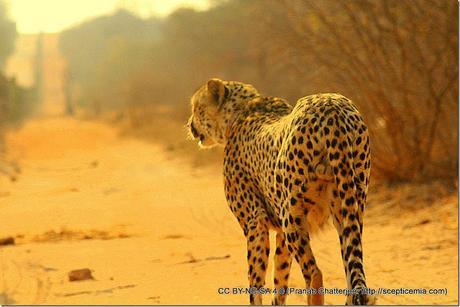
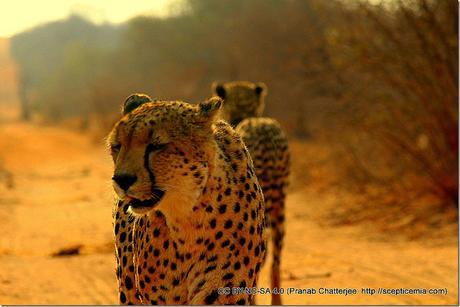
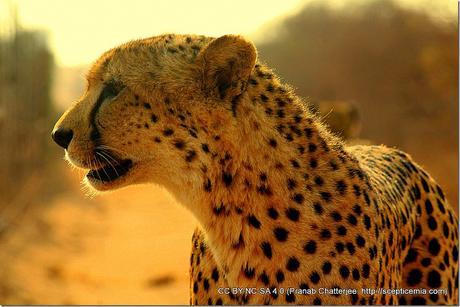
They went about their own business, tracking trails, and smelling stuff, and leaving their imprint on plants and shrubs nearby, all the while, indulging us as we walked around with them.
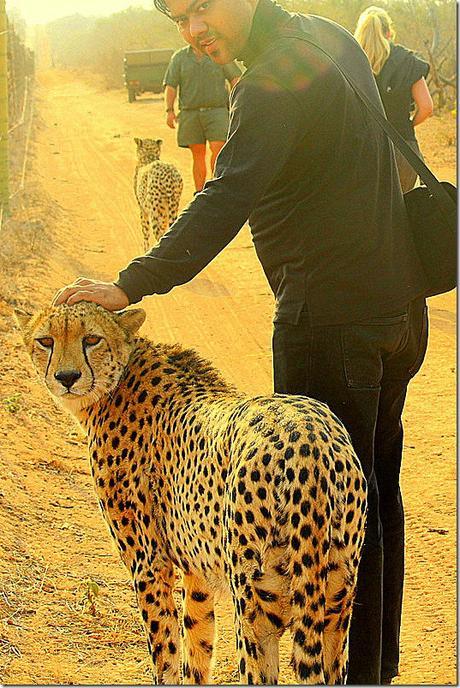
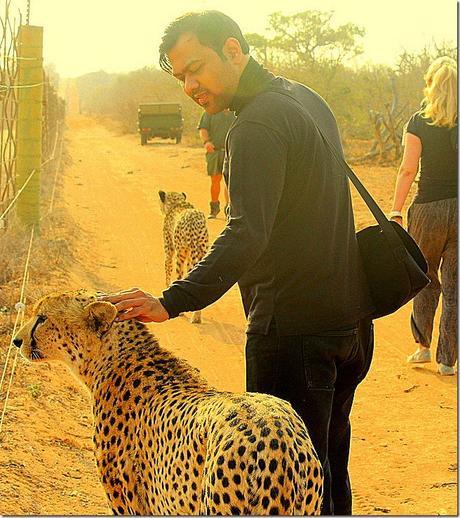
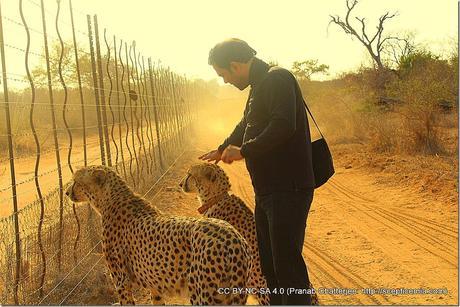
That morning more than made up for the bits and pieces of disappointment that we had felt the previous evening.
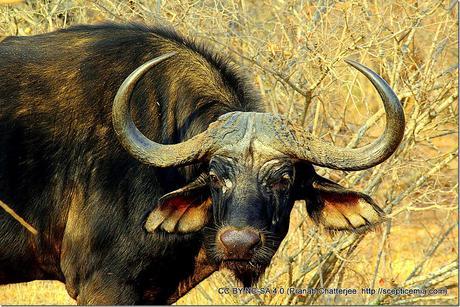
As we pulled out of the park, we came across yet another angry looking bull that bade us farewell. For not only were we pulling out of the park, but also, it was our last day of stay, and Gerhardt and his trusted van were waiting for us at the gate; it was time to go!
